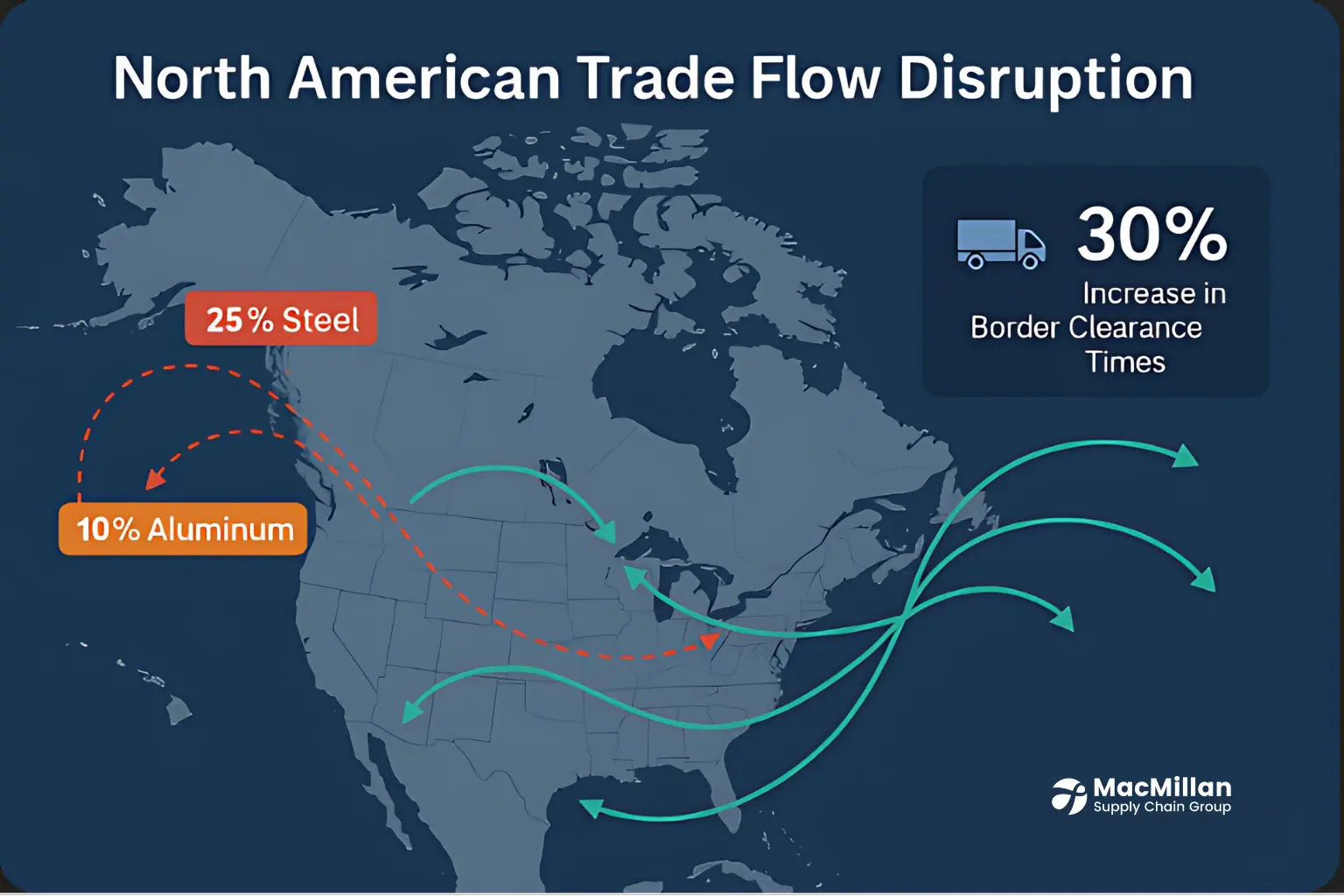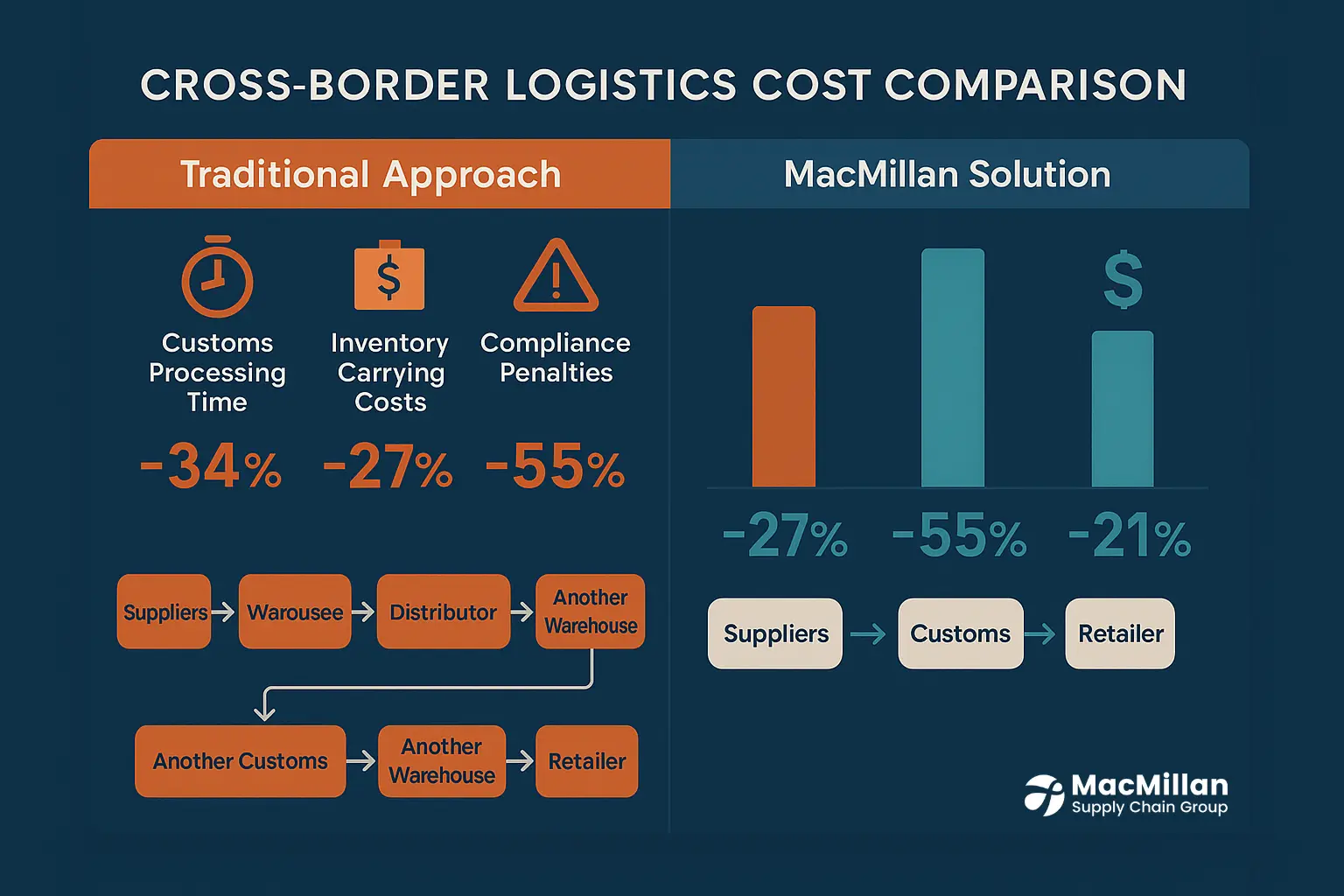How Macmillan SCG Strengthens Supply Chain Resilience in the Face of the US-Canada Trade War
Industries that depend on cross-border trade have been shaken by the recent increase in trade tensions between the US and Canada. Businesses are experiencing supply chain disruptions never seen before as a result of President Trump’s administration’s 25% tariffs on Canadian goods and Prime Minister Mark Carney’s targeted duties on $30 billion worth of US exports in retaliation. At Macmillan Supply Chain Group, we understand that these issues are practical roadblocks that call for quick, technologically advanced solutions. This blog examines how Canadian companies can protect their operations from fluctuations in trade while preserving cost effectiveness and client satisfaction. As a leading provider of Canada-US trade war supply chain solutions, Macmillan SCG offers actionable insights in times of uncertainty.
The New Trade Reality: Understanding the Economic Effects of Tariffs on Different Industries
18% of Canada’s yearly cross-border trade volume is directly impacted by the 2025 tariffs, which target industries ranging from consumer goods to auto parts. This means the following for SMEs:
Cost increases of 15–30% for imported raw materials from US suppliers
Delays of four to six weeks at important border crossings, such as Ambassador Bridge
Stockouts in inventory as a result of hasty reshoring attempts
Our team recently learned from a Toronto-based electronics retailer that their customs clearance times doubled overnight, putting $2 million in backorders at risk. These anecdotes highlight why supply chain diversification has become a top priority for 73% of Canadian companies looking for Canada-US trade war supply chain solutions.
 Creating a Supply Chain That Is Tariff-Proof: Four Key Elements
Creating a Supply Chain That Is Tariff-Proof: Four Key Elements
1. Flexible Warehousing Combined with Nearshoring
Businesses can do the following thanks to Macmillan’s 45 cross-dock facilities across Canada:
Keep products in duty-free areas until tariffs are resolved
Depending on current demand, move inventory between our 250,000 square foot GMP-certified warehouses
Get 40% less for shared warehouse space than for private leases
Case Study: By using our Windsor warehouse for staged US-bound shipments, a Montreal fashion brand was able to reduce border wait times by 58% and avoid $470,000 in tariffs. This is a clear example of how Canada-US trade war supply chain solutions can directly impact profitability.
2. Customs Optimization Driven by AI
The CARM system from CBSA is integrated with our proprietary Mantis WMS to:
99.1% accuracy in auto-classification of HS codes
Use political sentiment analysis to forecast changes in tariffs
During inspections, create alternate routing scenarios
Our AI saved clients $28K per day in detention fees by rerouting 1,200 shipments through Sarnia in 4 hours during the Detroit border slowdown last month. These AI-driven capabilities are a cornerstone of our Canada-US trade war supply chain solutions.
3. Last-Mile Agility in Turbulent Times
With 90% of Canadian FSAs covered by next-day delivery, we help businesses:
Split inventories between urban fulfillment centers to bypass choke points
Deploy electric vehicles for tariff-exempt “green” shipments in carbon-tax regions
Offer customers real-time duty calculators at checkout
“After the tariffs hit, Macmillan’s same-day Toronto delivery let us absorb costs without raising prices,” notes a Kitchener-based medical supplier.
This agility is key in implementing effective Canada-US trade war supply chain solutions.
4. Sustainability as a Protective Factor
Our Net-Zero Logistics Program converts ROI from regulatory compliance:
Compared to diesel alternatives, an electric fleet lowers fuel costs by 34%
22% of tariff-related costs are offset by carbon credit trading
AI-optimized routes avoid crowded borders while reducing emissions
Sustainability isn’t just a goal—it’s a tool within Canada-US trade war supply chain solutions.
Beyond the Headlines: Future-Proofing
The Benefit of Automation
Given that 38% of logistics companies in Canada are experiencing a labor shortage, our facilities leverage:
Autonomous mobile robots (AMRs) that increase picking speed by four times
Computer vision systems that audit 100% of inbound/outbound shipments
Blockchain-based smart contracts for instant tariff rebate claims
Diplomatic Winds of Change
While Carney’s team negotiates, we’re preparing clients for multiple scenarios:
Status Quo Contingency: Buffer stock management via our Halifax deep-sea port access
Escalation Playbook: Temporary manufacturing partnerships through our Mexico 3PL network
Resolution Readiness: Just-in-time inventory reactivation protocols
 Why Canadian Businesses Choose Macmillan
Why Canadian Businesses Choose Macmillan
A Partner, Not Just a Provider
Our 3-Step Migration Guarantee eliminates transition risks:
Seamless Integration: 48-hour onboarding with existing 3PLs
Stress Testing: Using historical trade data, tariff surges were simulated
Support Around-the-Clock: Committed account managers knowledgeable about USCBP and CBSA compliance
By the Numbers:
99.4% order accuracy in spite of SKU explosions brought on by tariffs
97% of 3.1 million shipments are handled on time each year
Since 2020, last-mile optimization has saved $6.51 billion for clients
These figures validate our role as a leader in Canada-US trade war supply chain solutions.
Using Trade Difficulties to Gain a Competitive Advantage
The Canadian–US trade war is about strategically adapting, not just surviving. At Macmillan SCG, we have assisted more than 40 industry leaders in converting their supply chains into networks that are resilient to tariffs and responsive. The first step toward stability is having a discussion, whether that involves using our cross-dock network or our AI customs platform. If you’re searching for proven Canada-US trade war supply chain solutions, we’re ready to support you.
Ready to Future-Proof Your Supply Chain?
→ Explore our Tariff Mitigation Playbook
→ Schedule a free logistics audit with our trade experts
→ Follow us on LinkedIn for real-time tariff updates
Because in turbulent times, the right partner makes all the difference.
FAQS
If you import from or export to the U.S., you'll face direct impacts through tariffs, increased customs scrutiny, and potential delays at border crossings. Even if you don't trade directly with the U.S., you may experience indirect effects through your suppliers or customers who do. Many GTA businesses report 15-20% higher input costs due to tariffs being passed through the supply chain. Working with a local 3PL like MacMillan Supply Chain Group can help you navigate these challenges with our expertise in cross-border logistics.
During the Mark Carney meeting, discussions focused on critical minerals supply chains, automotive sector integration, and potential exemptions for Canadian products from national security tariffs. While no immediate policy changes resulted, both sides agreed to establish working groups on supply chain resilience and critical minerals cooperation. This represents a potential thawing in relations, though concrete tariff reductions remain elusive.
The USMCA negotiations resulted in several key changes from NAFTA, including stricter rules of origin for automotive products (75% North American content vs. 62.5% under NAFTA), new labor value requirements, enhanced intellectual property protections, and updated digital trade provisions. However, the USMCA doesn't prevent either country from imposing tariffs under national security provisions, which is how the current trade war operates despite the agreement being in place.
The Canadian automotive sector has been hit hardest, with integrated supply chains now facing multiple tariffs as components cross borders during production. The Canadian energy sector, particularly oil exports, has also experienced significant disruption. Steel and aluminum manufacturers were the first affected and continue to face challenges. Food producers, particularly dairy and poultry, have seen market access issues despite USMCA provisions. Technology companies dealing with critical minerals for electronics also face new barriers.
The Canadian economy has shown remarkable resilience through diversification. LNG exports to Asia and Europe have increased significantly. The TSX outlook remains cautiously positive, with trade-exposed sectors underperforming but domestic-focused industries showing strength. The Bank of Canada has adjusted monetary policy to account for tariff-driven inflation, while government programs have provided targeted support to affected industries. Overall GDP growth has slowed but remained positive at 1.2% annually despite these headwinds.
Retaliatory tariffs are countermeasures imposed by Canada in response to U.S. tariffs. Canada has placed tariffs on $16.6 billion of American goods, targeting products from politically sensitive regions. These retaliatory tariffs create additional complexity for cross-border supply chains, as companies must track both U.S. tariffs on Canadian goods and Canadian tariffs on U.S. goods. This creates a challenging environment for logistics planning and often results in American market backlash as U.S. exporters face reduced competitiveness in the Canadian market.

 Creating a Supply Chain That Is Tariff-Proof: Four Key Elements
Creating a Supply Chain That Is Tariff-Proof: Four Key Elements Why Canadian Businesses Choose Macmillan
Why Canadian Businesses Choose Macmillan